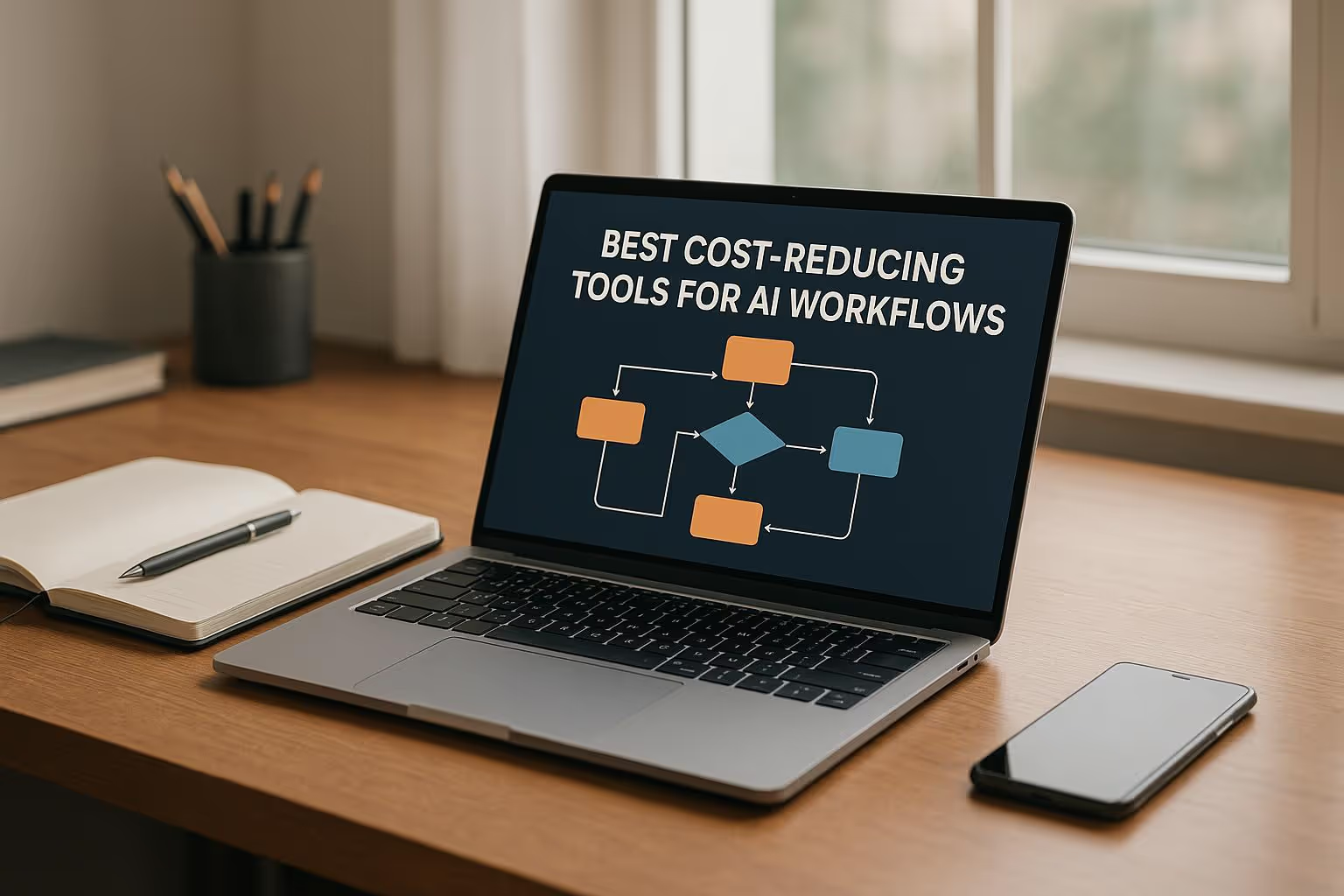
AI workflows can be expensive and complex, especially when managing multiple disconnected tools. Centralized platforms simplify operations, reduce costs, and improve transparency. Below are the top tools to streamline your AI workflows and save up to 98% on expenses:
These platforms improve efficiency, reduce tool sprawl, and bring real-time financial control to AI operations. Whether you're starting small or managing enterprise-scale workflows, there's a solution tailored to your needs.
When it comes to cutting expenses while managing AI operations, certain features of AI workflow platforms stand out as game-changers. These platforms streamline processes, eliminate inefficiencies, and help businesses manage resources more effectively. Here’s how they make it happen:
Centralized orchestration is a cornerstone of cost efficiency. By bringing various models under one roof, it eliminates duplicate fees and simplifies vendor management. This approach not only saves money but also reduces the hassle of juggling multiple vendor relationships.
Automated workflow management slashes labor costs by automating routine tasks. It intelligently routes requests to the most cost-effective model and adjusts resources based on demand. This prevents teams from unnecessarily using expensive premium models for tasks that less costly options can handle just as well.
Real-time cost tracking provides detailed insights into spending as it happens, helping avoid budget overruns. These platforms let you see exactly what each AI interaction costs, identify which models are draining your budget, and pinpoint areas where spending can be optimized without compromising performance.
Governance and compliance features add another layer of cost-saving by safeguarding data, maintaining audit trails, and enforcing access controls. These measures prevent expensive compliance mistakes and unauthorized usage, which can lead to unexpected charges.
Resource optimization ensures that every dollar is spent wisely. By selecting efficient models, batching requests, and offering performance benchmarks, these platforms help businesses get the most value out of their AI investments.
For businesses in competitive markets, especially in the U.S., these features aren’t optional - they’re critical for staying profitable while scaling AI initiatives. Without these cost-saving mechanisms, companies risk overspending on AI, turning it into a financial drain rather than a valuable tool.

Prompts.ai serves as a comprehensive AI orchestration platform, bringing together over 35 top-tier language models - including GPT-5, Claude, LLaMA, and Gemini - into a single, streamlined interface. This integration addresses the challenges U.S. enterprises face with fragmented AI tools and vendor relationships, offering a smarter approach to managing costs and complexity.
Managing multiple tools and contracts becomes a thing of the past with Prompts.ai. By centralizing various models, the platform simplifies operations and eliminates overlapping subscription fees. Its TOKN credit system transforms traditional fixed monthly costs into flexible, usage-based expenses, ensuring businesses pay only for what they use.
The platform’s interface allows teams to compare model performance side-by-side, enabling informed decisions about which models to use. This ensures workflows are directed to the most cost-effective options, avoiding unnecessary reliance on premium models when simpler solutions suffice.
Prompts.ai ensures full visibility and accountability for every AI interaction. Built-in analytics track token usage in detail, providing actionable insights into spending.
Higher-tier plans also feature TOKN pooling, allowing organizations to share credits across teams and projects. This prevents waste from unused credits and ensures departments with higher demands aren’t left short while others sit on unused resources.
Prompts.ai not only offers transparent pricing but also meets the scalability and regulatory requirements critical for U.S. enterprises. All business plans include compliance monitoring and governance tools, providing detailed audit trails essential for industries like healthcare, finance, and legal services.
The platform’s storage pooling feature allows teams to share data resources efficiently, cutting down on redundant storage expenses. Additionally, enterprise-grade security controls ensure sensitive data remains within the organization, avoiding compliance risks that could lead to costly penalties.
Prompts.ai builds on its streamlined workflows and cost tracking by introducing intelligent automation. Routine tasks are automated, and workflows are optimized to use the best models based on both cost and performance. This ensures premium models are only employed when their advanced features are absolutely necessary.
Business plans include usage analytics, offering insights into consumption patterns. Teams can set spending limits, monitor usage in real time, and receive alerts before nearing budget thresholds. These tools help prevent unexpected overages, keeping AI initiatives on track and within budget.
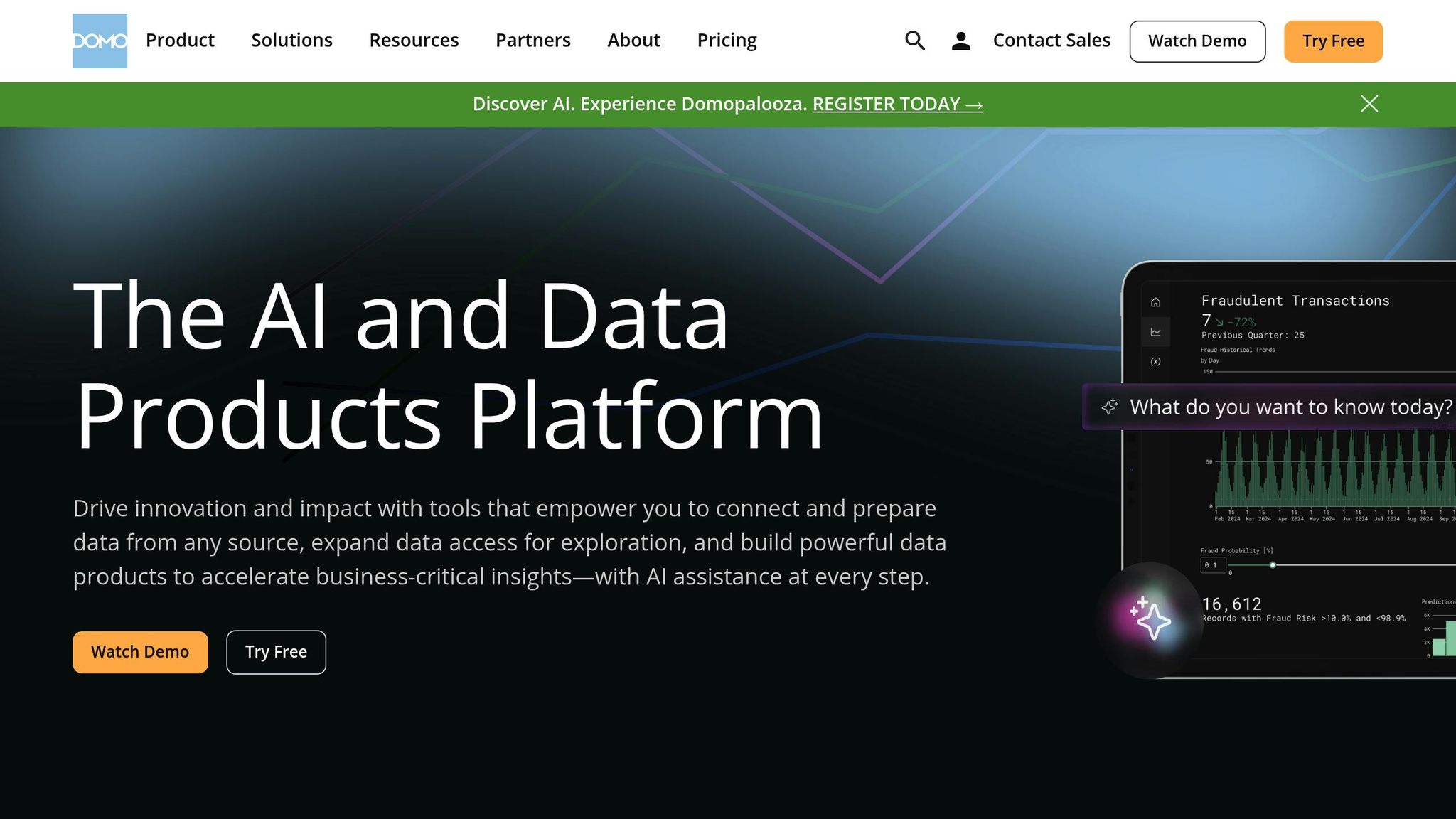
Domo is a business intelligence platform that brings AI workflows and data analytics together, helping businesses cut costs and scale their AI operations. By integrating real-time analytics, automated workflows, and AI-driven insights, Domo provides a comprehensive solution for streamlining processes and improving efficiency. Here's a closer look at how Domo enhances workflow management and cost control.
Fragmented data systems can be a significant challenge for many U.S. enterprises, often leading to inefficiencies and higher costs. Domo addresses this by connecting various data sources, applications, and teams, creating a seamless and unified workflow environment. This eliminates the need for multiple subscriptions and expensive custom integrations.
With its low-code/no-code interface, Domo empowers business users to design and deploy advanced automation without requiring extensive technical expertise. This approach reduces reliance on costly development resources and speeds up the deployment of AI-driven solutions. Teams can quickly adjust workflows to meet changing business needs, avoiding the delays often associated with traditional development methods. This flexibility not only enhances efficiency but also enables real-time cost tracking and ensures scalable compliance.
By 2025, it's estimated that AI-enabled workflows will account for 25% of enterprise processes. Domo is well-positioned to support this growth, offering the tools enterprises need to expand their AI capabilities without adding unnecessary complexity or costs.
Domo's dashboard features provide clear insights into the performance and resource usage of AI workflows. Businesses can monitor spending patterns, pinpoint inefficiencies, and make informed decisions about resource allocation. By automating decision-making processes, Domo reduces the need for manual oversight, helping organizations maintain a high level of operational efficiency.
For U.S. businesses, compliance with regulations like HIPAA, SOC 2, and GDPR is non-negotiable. Domo addresses these needs with features such as audit trails, role-based access controls, and data residency options. These tools help minimize regulatory risks, enabling companies to confidently expand their AI initiatives.
Domo is also designed to grow alongside an enterprise. It can handle large data sets and user bases without requiring significant infrastructure investments. Businesses can start small and scale up as their needs evolve, avoiding the upfront expenses of over-provisioning.
Domo excels in automating decision-making and optimizing resources to maximize efficiency. By connecting data, automating processes, and scaling smart workflows, the platform reduces manual tasks and lowers operational costs. This combination of automation and resource optimization makes it an essential tool for enterprises looking to streamline their operations and achieve long-term savings.
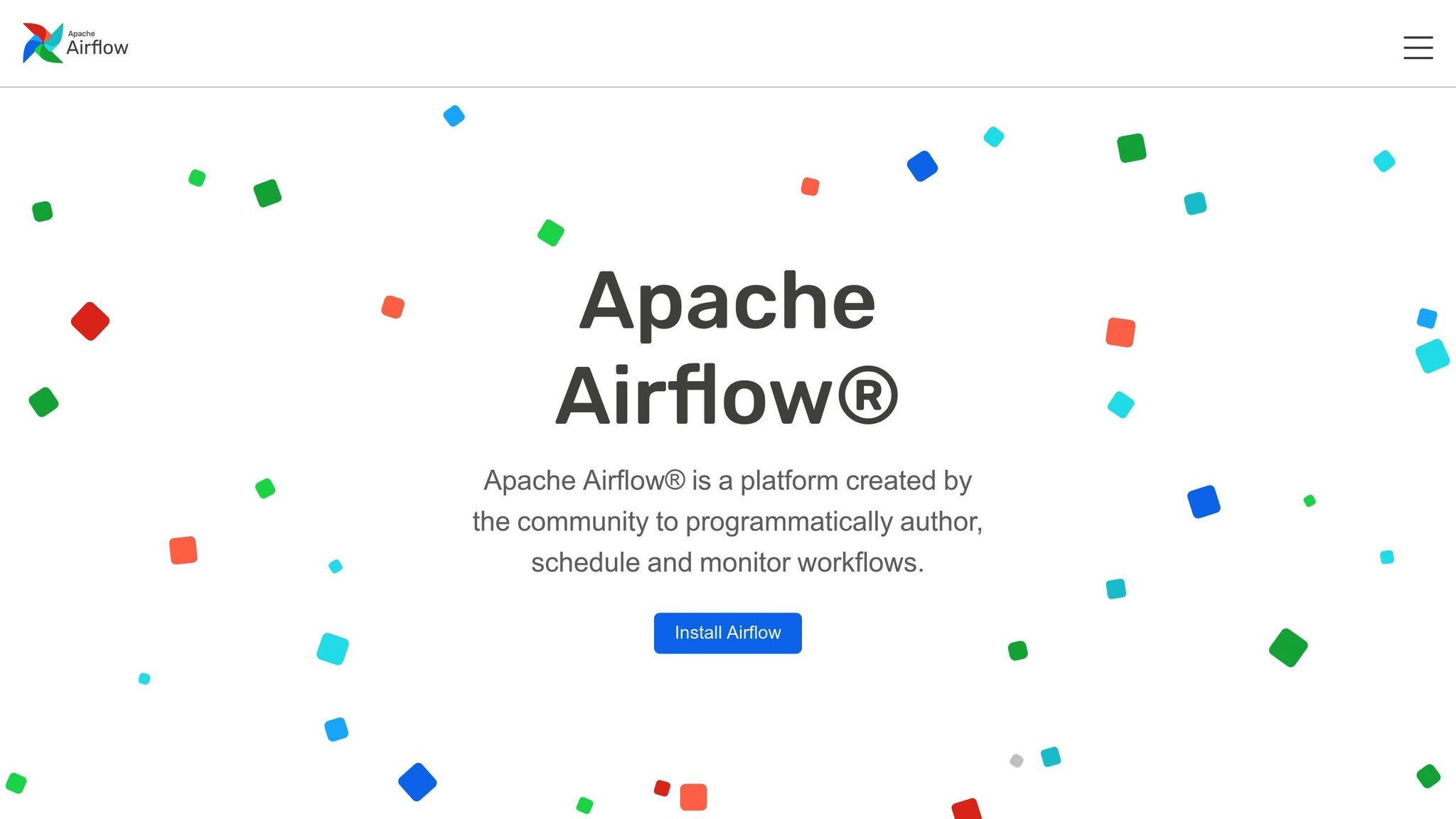
Apache Airflow stands out as a powerful tool for orchestrating workflows, especially when aiming to cut costs. Originally developed by Airbnb in 2014, this open-source platform uses Directed Acyclic Graphs (DAGs) to define workflows. By leveraging Python, teams can code, schedule, and monitor tasks efficiently, making it a practical choice for automating AI workflows in a cost-conscious manner.
Airflow’s DAG-based structure provides a clear, visual representation of task dependencies. This makes it easier for teams to manage even the most intricate pipelines. Additionally, workflows can be directly integrated with project repositories, enabling collaborative development and seamless version control.
One of Airflow’s standout features is its ability to handle failures gracefully. With configurable retry mechanisms, workflows can resume from the point of failure instead of restarting from scratch. This ensures smoother operations, whether tasks are executed locally or in cloud environments.
Being open-source, Apache Airflow allows customization to fit specific workflow needs. It scales effortlessly as projects expand, eliminating the necessity for expensive proprietary tools. This adaptability helps enterprises allocate resources more efficiently while keeping costs in check.
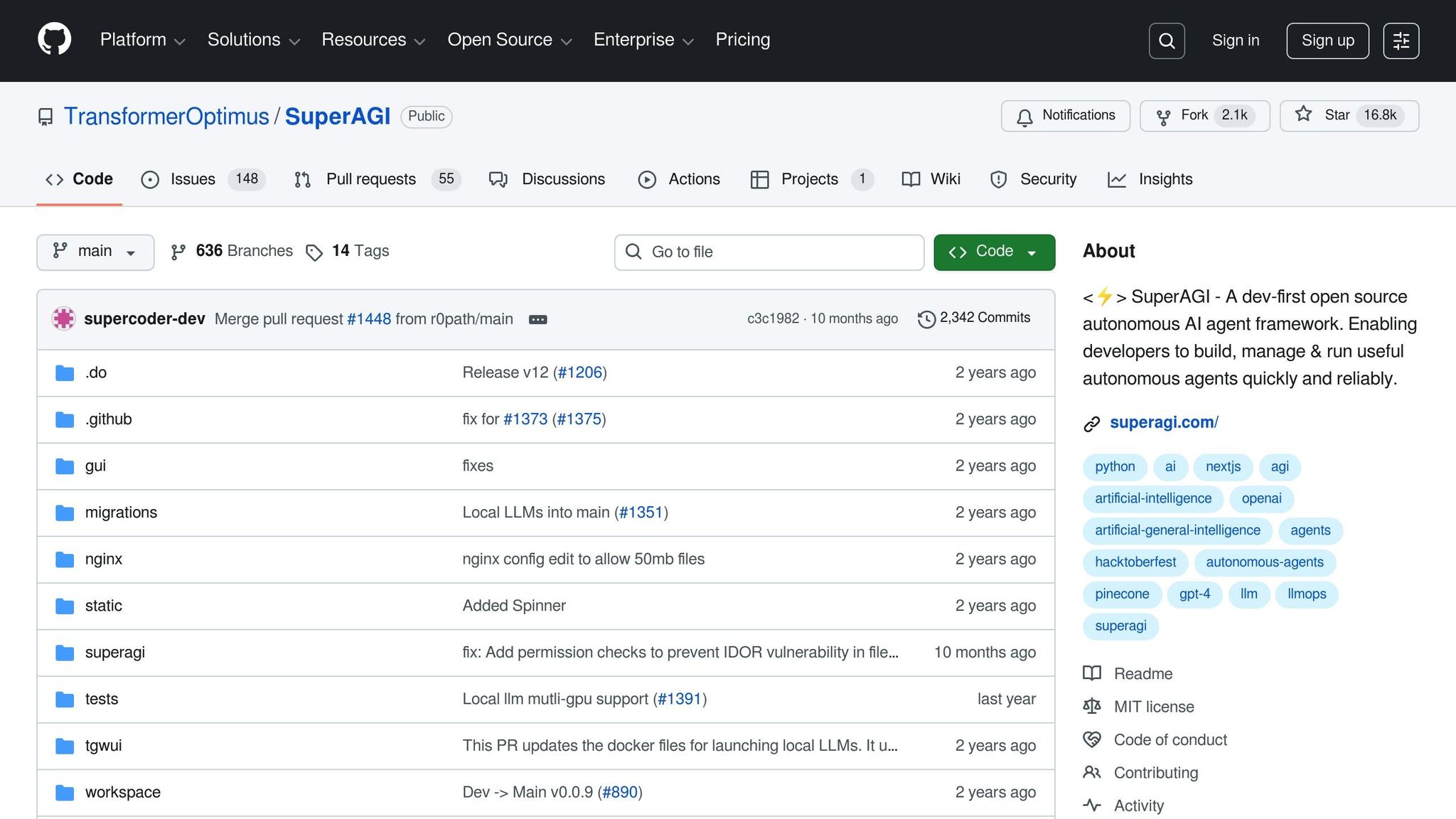
SuperAGI is an open-source platform crafted to help organizations build, orchestrate, and manage autonomous AI agents and workflows with a focus on cost control, scalability, and adaptability. It equips businesses with enterprise-level orchestration tools to streamline AI operations while maintaining budget efficiency.
SuperAGI's modular design offers a centralized interface for deploying, monitoring, and managing multiple AI agents effortlessly. It integrates seamlessly with leading AI models like OpenAI, Anthropic, and Google Gemini, while also supporting custom integrations through its modular framework. This setup allows teams to link APIs, databases, and cloud services, creating workflows that require minimal manual intervention. Such integration not only simplifies operations but also enables precise cost tracking, ensuring better financial oversight across AI activities.
The platform provides real-time insights into resource usage and agent performance, offering a clear view of spending as it happens. This transparency allows teams to make informed decisions and optimize their AI investments effectively.
SuperAGI caters to US enterprises with strict regulatory requirements by offering both on-premises and cloud deployment options. This ensures sensitive data remains secure and adheres to data sovereignty laws. As workloads grow, the platform scales efficiently, making it a dependable solution for enterprise-level applications.
SuperAGI excels at automation by dynamically allocating resources and reducing idle compute time. According to industry reports, this approach can lower operational costs by 30–50% and reduce licensing expenses by up to 80%. By automating repetitive tasks, the platform not only cuts costs but also allows teams to focus on more strategic, high-value activities.
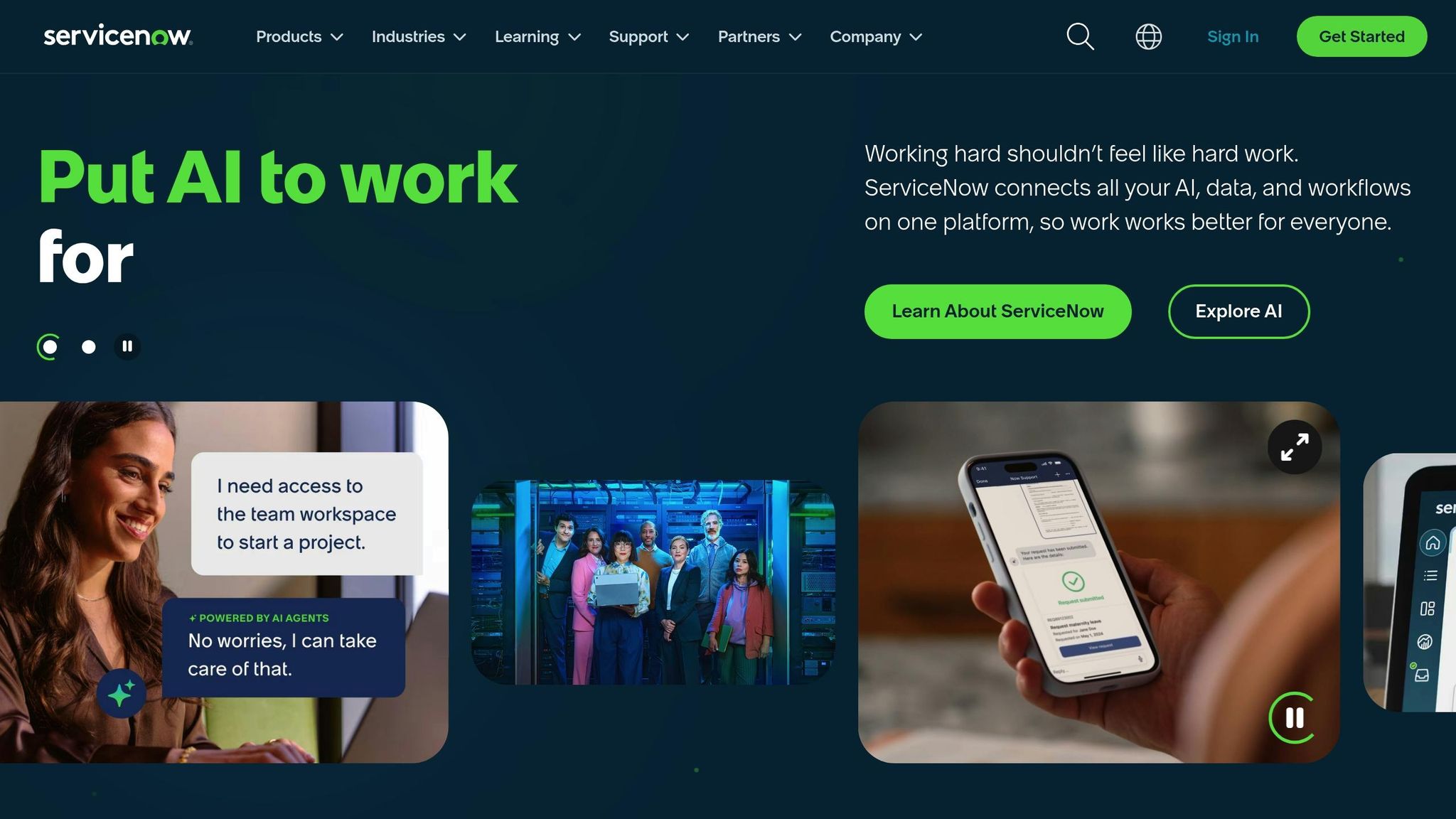
ServiceNow AI Agents brings IT service management into a streamlined, AI-powered system designed for large organizations. By leveraging artificial intelligence, it automates workflows and delivers measurable cost savings across IT operations and business processes.
This platform integrates seamlessly with tools like SAP, Oracle, Microsoft 365, and AWS, unifying AI operations under one roof. By consolidating workflow management, it eliminates the need for multiple, disconnected solutions, simplifying operations.
With its Process Automation Designer, teams can create cross-department workflows using a simple drag-and-drop interface. This feature allows IT teams to automate tasks such as incident routing, approval management, and action triggers across systems without requiring extensive coding. The result? Faster development times compared to traditional custom coding methods.
Additionally, this centralized approach offers detailed cost insights, giving organizations a clearer picture of their AI investments.
ServiceNow provides real-time cost monitoring through its Performance Analytics tools, offering a breakdown of expenses by department, workflow type, and resource usage. This granular view enables finance teams to allocate AI-related costs with precision.
The Cost Management Dashboard further enhances visibility by highlighting spending trends and pinpointing areas for optimization. IT leaders can access reports that identify resource-heavy workflows and evaluate where automation delivers the greatest return on investment. These insights empower organizations to scale AI initiatives strategically while keeping budgets in check.
For organizations in the United States, compliance and scalability are critical. ServiceNow addresses these needs with its Governance, Risk, and Compliance (GRC) features. These tools automatically enforce regulatory standards like SOX, HIPAA, and FedRAMP, while maintaining detailed audit trails to simplify compliance reporting.
The platform's cloud-native infrastructure adjusts dynamically to demand. During high-usage periods, additional compute resources activate automatically, while scaling down during slower times helps control costs. This elastic scalability eliminates the need for over-provisioning and reduces infrastructure expenses compared to fixed-capacity setups.
ServiceNow AI Agents use machine learning to adapt to user behavior and analyze historical ticket data, enabling the system to predict and prevent potential issues before they disrupt operations. This proactive approach lowers incident response costs and minimizes downtime.
The platform’s Virtual Agent feature automates routine service requests, reducing the workload on human support teams. By handling repetitive tasks, it allows organizations to manage higher service volumes without needing to scale up staffing. This combination of automation and efficiency leads to cost savings while improving response times and overall service quality.

Microsoft AutoGen represents a step forward in the development of AI workflow management, focusing on coordinated interactions between multiple AI agents. While details about its features and cost-saving strategies remain limited due to its early development phase, the platform promises to streamline workflows through intelligent agent collaboration. To learn more about its progress and potential, keep an eye on official Microsoft updates as they continue to refine and expand AutoGen's functionality for more efficient workflow solutions.
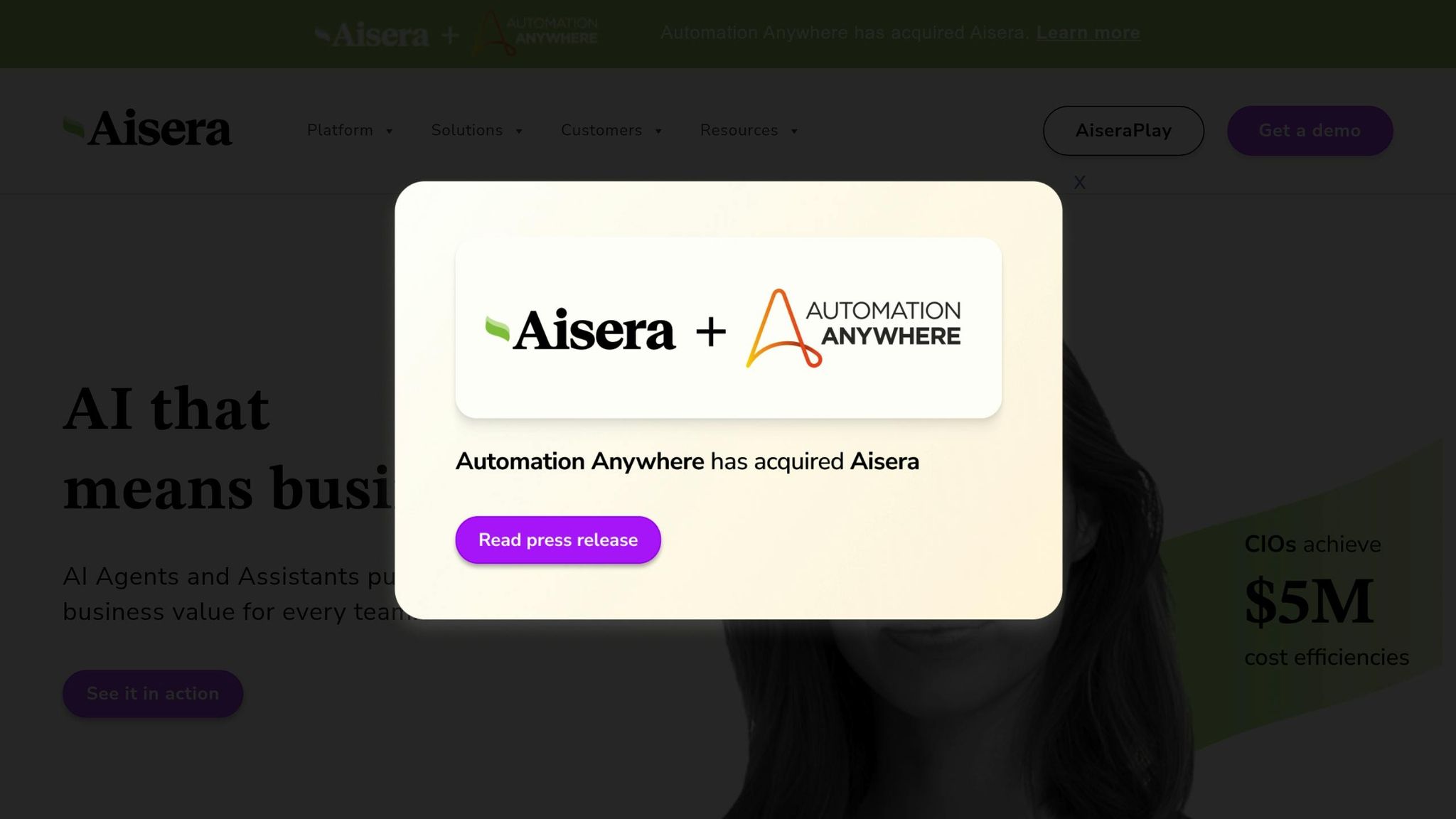
Aisera's cost-saving strategies for AI workflows are not well-documented compared to other platforms. This lack of detailed information highlights the need for careful evaluation when choosing an AI workflow solution, as understanding cost-reduction methods is key to making well-informed decisions.
At this time, verified details on Aisera's specific methods for reducing costs in AI workflows are unavailable. Updates to this section will be provided once reliable data becomes accessible.

Zapier AI Agent Builder stands out as a practical tool for automating workflows and integrating systems seamlessly. Designed to simplify repetitive tasks, this platform empowers businesses to create AI-driven agents that operate across multiple applications - no technical expertise required.
With access to over 6,000 applications, Zapier AI Agent Builder consolidates automation into a single platform. It streamlines processes like lead qualification, customer support routing, and data synchronization, cutting down on manual work and operational costs. Thanks to its no-code design, users can build advanced AI agents without needing to write a single line of code.
By eliminating the need for custom APIs or costly middleware, businesses can connect their tools efficiently. This streamlined setup not only saves on licensing fees for multiple automation tools but also provides a unified view of all automated workflows.
Zapier AI Agent Builder offers robust analytics to monitor agent performance and resource usage. Users gain insights into task completion rates, workflow bottlenecks, and resource allocation. This level of transparency allows businesses to refine their processes, ensuring resources are used wisely and costs remain under control.
The platform uses intelligent routing to assign tasks to the most suitable systems based on pre-set rules and AI analysis. This targeted approach reduces unnecessary processing and ensures optimal use of resources. Trigger-based automation ensures tasks are activated only when conditions are met, cutting down on idle resource consumption.
With its pay-per-task pricing model, businesses can align costs with actual usage. This flexible approach enables teams to start small, test workflows, and scale automation as needed, avoiding hefty upfront investments in complex systems.
For U.S. enterprises, Zapier AI Agent Builder offers features like audit logs and access controls to meet compliance requirements. Every automated action is logged, ensuring transparency for regulatory reporting and internal audits.
The platform also scales automatically to meet workflow demands, maintaining smooth operations during busy periods and adjusting to reduce costs during quieter times. This elasticity ensures consistent performance without requiring additional infrastructure investments.
Here’s a detailed look at how different platforms stack up in terms of features, cost-saving potential, pricing, and advantages for U.S. businesses. This comparison highlights how unified platforms can streamline AI workflows and cut down expenses.
| Tool | Key Features | Cost-Saving Benefits | Pricing Model | U.S. Advantages |
|---|---|---|---|---|
| Prompts.ai | Access to 35+ leading LLMs; real-time FinOps; enterprise governance; streamlined workflows | Cuts AI software costs significantly and eliminates tool sprawl with flexible pay-as-you-go TOKN credits | Personal plans: Free to $99/month; Business plans: $99–$129 per user/month | Enterprise compliance, audit trails, U.S.-based support, trusted by Fortune 500 companies |
| Domo | Cloud-native analytics, automated data pipelines, mobile dashboards | Consolidates analytics tools and enhances reporting efficiency | Custom pricing | SOC compliant, HIPAA-ready, with dedicated U.S. support |
| Apache Airflow | Open-source workflow orchestration with Python-based DAGs and integrations | Zero licensing fees and lower operational costs | Free open-source; optional managed services | Broad cloud provider support and a strong U.S. developer community |
| SuperAGI | Multi-agent orchestration for autonomous task execution with tool integration | Simplifies automation workflows and reduces the need for multiple tools | Open-source with enterprise add-ons | Active U.S. tech community and seamless cloud integration |
| ServiceNow AI Agents | ITSM integration, conversational AI, workflow automation, predictive analytics | Optimizes IT operations and reduces support overhead | Enterprise licensing | Local data centers, federal-compliant features, and strong U.S. enterprise presence |
| Microsoft AutoGen | Multi-agent conversations with customizable roles; Microsoft ecosystem integration | Reduces third-party tool reliance by leveraging existing Microsoft licenses | Included with Microsoft 365; Azure compute fees apply | Seamless fit for U.S. enterprises, including government cloud options |
| Aisera | Conversational AI for IT, HR automation, and predictive insights | Automates routine tasks, lowering departmental support costs | Per-employee pricing | Dedicated account management, U.S.-based data centers, and enterprise tool integration |
| Zapier AI Agent Builder | No-code automation with thousands of app integrations and performance analytics | Pay-per-task model aligns costs with usage, reducing middleware expenses | Affordable tiered plans | Extensive integration with U.S. SaaS tools and strong compliance features |
While open-source platforms like Apache Airflow and SuperAGI offer cost-effective entry points, managed services and enterprise-grade tools often come with higher upfront investment. Prompts.ai stands out with its transparent TOKN credit system, eliminating recurring subscription fees while offering access to advanced AI models.
For U.S. businesses, compliance and data sovereignty are top priorities. Platforms like Prompts.ai and ServiceNow AI Agents provide robust compliance measures, local data centers, and enhanced governance features - key for industries with strict regulatory requirements.
The best choice ultimately depends on your current AI setup and goals. Businesses consolidating workflows onto platforms like Prompts.ai can streamline operations and achieve noticeable cost savings, while those starting fresh might benefit from the flexibility of open-source or pay-per-use options.
An AI workflow tool designed to reduce costs can transform disjointed processes into efficient operations, ultimately saving both time and resources. The platforms discussed here each bring their own strengths to the table. For instance, Apache Airflow provides open-source adaptability, while Prompts.ai delivers enterprise-level precision with unified model access and a flexible pay-as-you-go TOKN system.
For organizations just beginning their AI journey, open-source solutions like SuperAGI can be a smart choice. These tools eliminate licensing fees and offer robust automation features. However, it’s important to consider the potential hidden costs - such as maintenance, staff training, and integration - which can accumulate over time. In many cases, managed platforms prove to be more cost-effective as operations scale.
For larger, established enterprises, unified platforms are often the better fit. They simplify workflows, ensure compliance, and offer pricing models that adapt to your usage. A pay-per-use approach, in particular, is ideal for businesses with varying AI workloads or seasonal spikes in demand.
U.S.-based companies should prioritize platforms that meet strict compliance standards and provide dedicated enterprise support. The comparison table underscores how these tools integrate smoothly with existing infrastructure, reducing technical hurdles and lowering the total cost of ownership.
Ultimately, your decision will hinge on factors like your organization’s current level of AI adoption, compliance needs, and long-term growth plans. Whether you lean toward managed services or open-source options, the key is finding a solution that aligns with your operational requirements. The right platform doesn’t just save money - it shortens training periods, speeds up deployment, and enhances team productivity, setting your business up for sustained success.
Centralized orchestration platforms are game-changers when it comes to managing AI workflows efficiently. By automating and simplifying complex processes, they help streamline operations, eliminate redundancies, and make the best use of available resources - all of which can lead to significant cost savings.
These platforms bring everything together into one unified system, reducing the need for manual intervention and ensuring resources are allocated where they’re needed most. For organizations looking to get the most out of their AI investments while keeping expenses in check, this approach offers a smart and effective solution.
A pay-as-you-go model, like TOKN credits, brings several perks when it comes to managing AI expenses. One standout advantage is flexibility - you only pay for what you actually use. This means you can adjust your spending as your project needs change, whether you're scaling up for a big initiative or scaling down to save on costs, all without locking yourself into hefty upfront investments.
Another major benefit lies in budget control and predictability. With real-time tracking, you can keep a close eye on usage, helping you stay within budget and align spending with your business goals. Plus, this approach cuts down on waste since you’re not paying for unused capacity. This is especially helpful for businesses dealing with fluctuating workloads or experimenting with AI projects.
Compliance and governance play a crucial role in AI workflow platforms, ensuring businesses stay aligned with legal, ethical, and regulatory standards. For U.S. companies, this involves adhering to frameworks like GDPR, CCPA, and sector-specific regulations such as HIPAA in healthcare. Meeting these requirements is not just about avoiding fines - it’s about safeguarding sensitive information and maintaining the trust of customers.
Effective governance also minimizes risks, promotes transparency in AI-driven decisions, and keeps organizations in step with shifting government policies. By focusing on compliance, businesses can build AI workflows that are not only secure and dependable but also uphold ethical standards, paving the way for sustained success.


